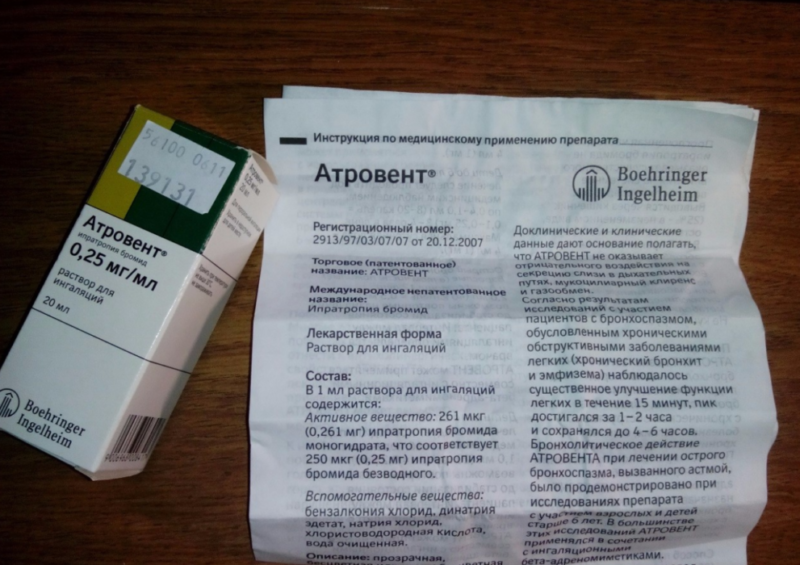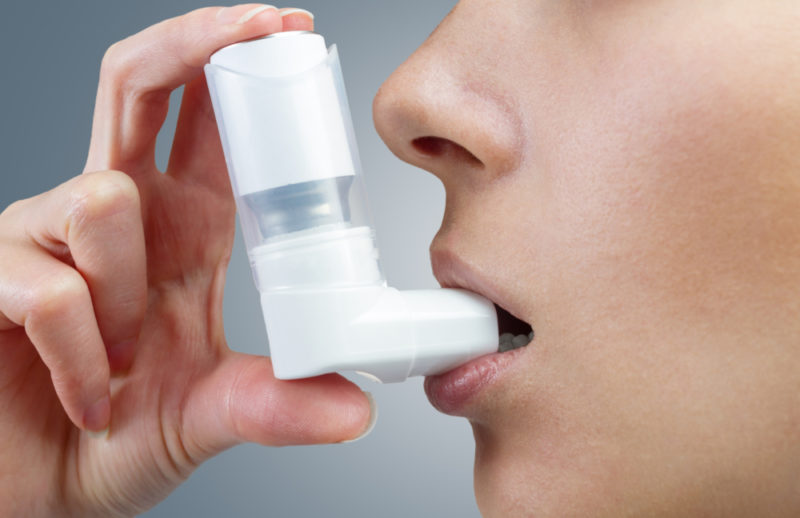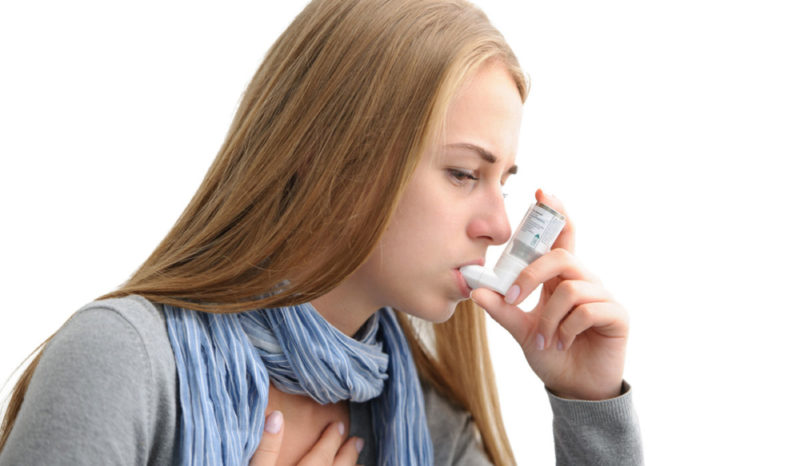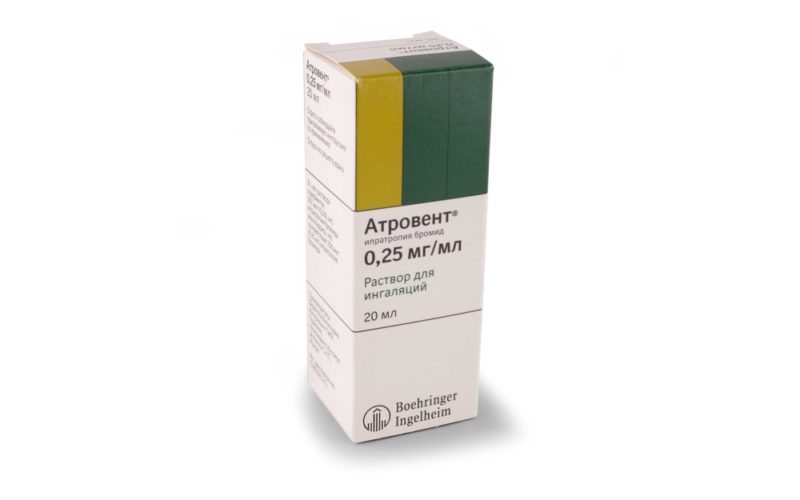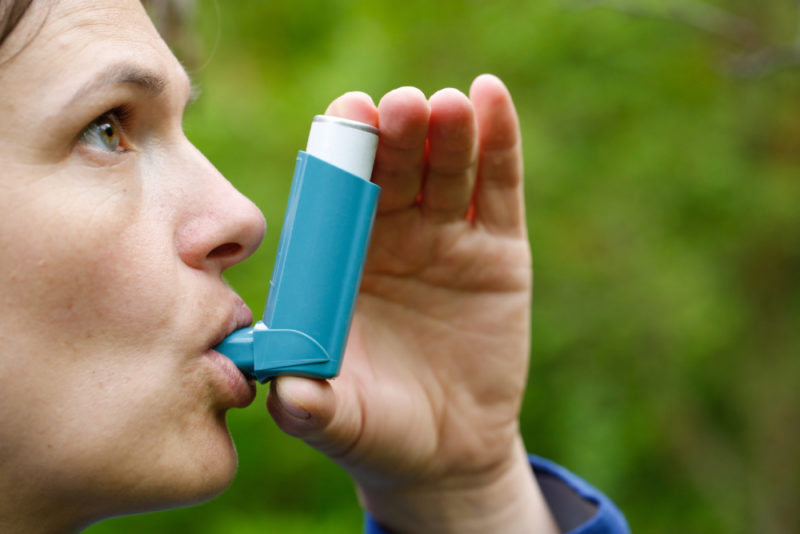Atrovent for inhalation is a drug whose action is aimed at relieving tension of the bronchi, reducing the allocation of bronchial glands. The use of the drug leads to normalization of breathing, relieving edema and continuous coughing, and the cessation of sputum production during respiratory diseases.
Material Content:
Composition and release forms
Atrovent or Ipratropium bromide (Ipratropium bromide) is the empirical name for atropine bromide, in the molecular structure of which the nitrogen atom is connected to isopropyl. Unlike atropine, Atrovent has no effect on the central nervous system.
The medication is available in the following forms:
- Atrovent H inhalation aerosol with active substance concentration (ipratropium bromide) 0.021 mg per 1 dosed volume of injection. The drug is contained in a special bottle with an automatic dispenser with a volume of 10 ml;
- Atrovent solution for inhalation with a concentration of 0.25 mg / ml is packaged in dark glass bottles with a volume of 20 ml with the attached pipette.
Why is the drug prescribed?
A bronchodilator is prescribed for physiotherapy by inhaling the drug in a vapor or gaseous state (inhalation) in the treatment of the respiratory tract to relieve bronchospasm, as well as for preventive purposes.It is possible to combine with other drugs that have the property to expand and eliminate the tension of the bronchi with the use of medical nebulizers.
Atrovent is used in the following cases:
- in the presence of attacks of bronchial asthma;
- with chronic obstructive bronchitis;
- with chronic pneumonia;
- in case of colds, especially in elderly patients;
- in the postoperative period, accompanied by bronchospasm;
- in the process of preparing the respiratory system for the introduction of antibiotics and acid-containing drugs using aerosols;
- to detect signs of latent bronchospastic syndrome.
Instructions for taking Atroven for inhalation
It must be borne in mind that the dispenser has a special device that measures 1 dose of a drug with a certain concentration.
The effectiveness of relieving spasm, edema, and cessation of cough depends on its proper use.
The method of using an aerosol can and the procedure for injecting a substance:
- remove the safety cap from the spray device, perform several shakes of the spray can to create a finely dispersed mixture of medicine with gas, turn the container upside down;
- take a deep exhalation, prevent the mouthpiece of the balloon into the mouth and tightly wrap it around your lips;
- produce simultaneous pressing with two fingers on the bottom and the spray head, inhaling deeply the dose of the injected drug;
- hold your breath (if possible), for deep penetration of the drug into the bronchi and adsorption on the mucous surface;
- the mouthpiece is wiped with a disinfectant or washed with soap under water, put on a protective cap.
Atrovent for children is used as an aerosol from 3 years of age, inhalation with a solution - from 6 years.
Aerosol devices for injecting medication into the nasal cavity are prescribed for children from 6 years old, since a child at an earlier age does not have the skills to perform this procedure.
Instructions for use Atrovent for inhalation.
Metered aerosol is used:
- in order to prevent shortness of breath in chronic bronchitis and asthma. Assign 1-2 doses 3 times a day;
- during diseases associated with severe coughing attacks, swelling of the nasal mucosa and throat, profuse sputum production, exacerbation of bronchitis and asthma. Dosage is increased to 3 doses, the interval of use of the drug is expanded as necessary.
The inhalation solution is used to prepare formulations for procedures using special medical equipment: electric nebulizers, respirators, nebulizers.
There are different models and brands of devices. The drug can be used in combination with bronchodilators: adrenergic agonists (Orciprenaline), drugs containing xanthine (Theophylline), corticosteroids.
Rules for obtaining a solution for inhalation:
- electric sprayers have instructions for preparing the mixture using physiological saline (0.9 g of sodium chloride per 100 ml of distilled water);
- a single dose is from 4 to 8 drops per 4 ml of saline (you must follow the recommendations attached to the device instructions);
- carrying out the procedure using a manual sprayer is performed according to the instructions of the circular, while doing 20-30 breaths of undiluted solution.
After each procedure, inhalers are washed with detergents, if possible, wiped with disinfectant alcohol-containing or other solutions.
During pregnancy and lactation
The medication is strictly contraindicated for use in the initial stages of pregnancy. During the gestation, the use of any medication is prescribed by the attending physician, taking into account the possible risk of a negative impact on the development of the child and a positive therapeutic effect for the mother.
There are no clinically confirmed data on the absorption of the drug in breast milk. But to exclude all kinds of risks during the development of the newborn, when using the product it is necessary to transfer the baby to artificial feeding.
Drug interaction
The antispasmodic result from the use of atrovent is enhanced while taking with the drugs used in the treatment of parkinsonism, with the content of quinidine, coupled with tricyclic antidepressants.
Contraindications, side effects and overdose
Organizations for the use of the medication apply to cases of prolonged (systematic) use, with the exception of individual intolerance, which manifests itself in the first moments of the arrival of the atrovent on the mucous membrane of the nasopharynx.
Contraindications are:
- increased intraocular pressure;
- enlarged prostate gland;
- narrowing of the digestive tract;
- colon enlargement;
- initial pregnancy.
Inhalation procedures are mostly easily tolerated, but the anticholinergic effects of the drug can cause a negative effect on the respiratory system.
When inhaled, the following side effects are possible:
- dry mouth, accompanied by sore throat and cough;
- increased viscosity of sputum;
- heart palpitations;
- possible manifestation of extraordinary heart contraction;
- dry skin due to sweat gland dysfunction;
- interruptions in urination;
- slight weakening of vision.
To eliminate side effects, reduce the dose of the drug or extend the interval between inhalation procedures. In case of intolerance to side effects, the use of the drug is suspended.
With an overdose of the drug, the above symptoms occur, caused by the action of the substance. No particular adverse effects were observed.
Analogies of a bronchodilator
Synonyms of Atrovent: Atrovent, Ipratropium bromide, Itrop. Normosecretol. Preparations under these names contain ipratropium bromide as a medicine.
The domestic analogue is Troventol, which is used according to the same indications with a similar method of application, identical side effects.
Foreign analogues include: Ypravent (made in India), Ipratropium Steri-Neb (Great Britain), Spiriva (Germany).


